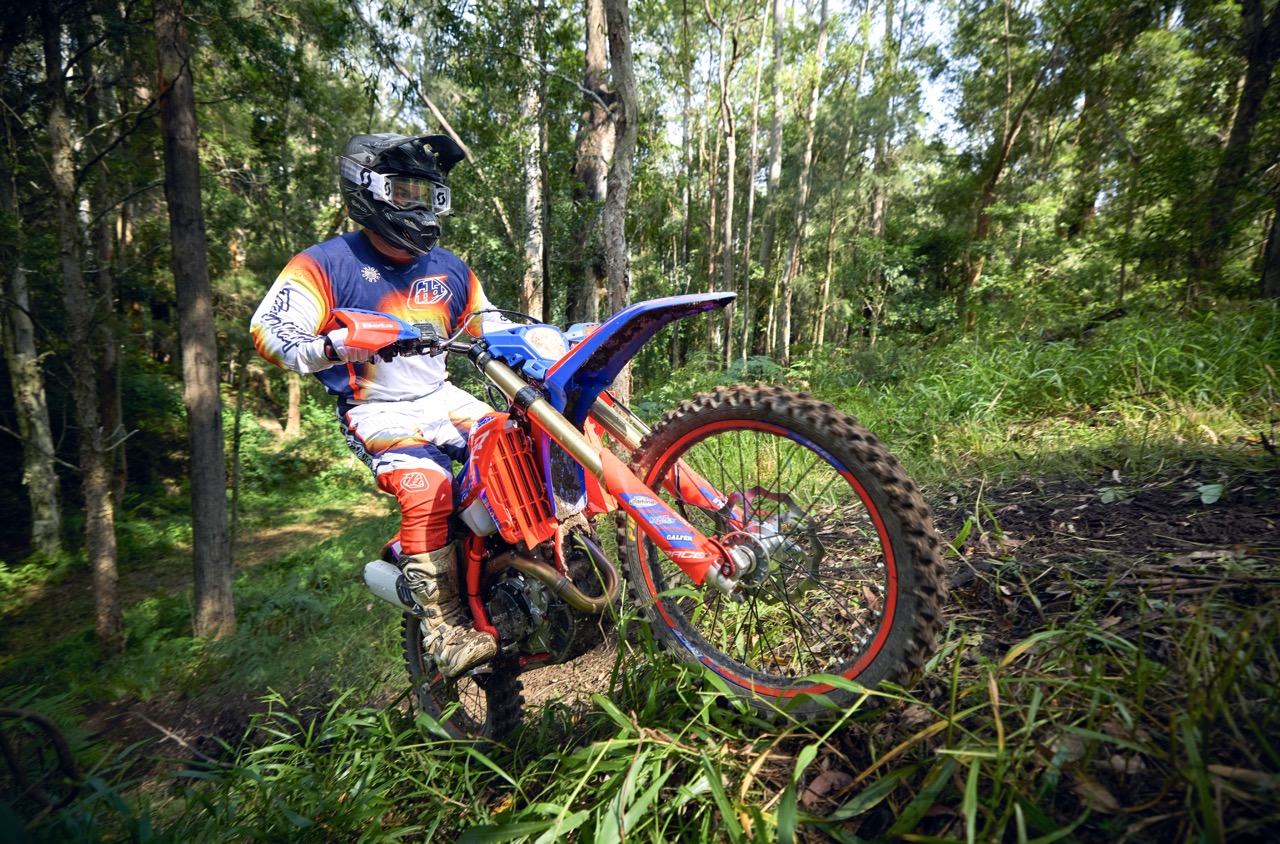Your tyres are really important when it comes to how your motorcycle handles. The tyres need to grip the surface so that the motorcycle can drive forward and also steer. If the rear tyre does not grip it will not propel the motorcycle in a forward direction and if the front tyre is slipping and sliding then the motorcycle will not steer. There are all kinds of rubber compounds and knob configurations designed to get the most traction on all different kinds of terrain but the best you can do is mousse tubes.
This is not a tyre feature so we are instead going to talk about what fills the inside of a tyre. A tyre needs internal pressure from within to keep its structure. If it does not have this internal pressure then the shape of the tyre will be compromised and the tyre will collapse and move around all over the rim giving us very little traction if any at all. To rectify this problem we insert a tube inside the tyre made from natural and synthetic rubbers which we can fill with air.

There are standard tubes that are approximately 1.5mm thick plus heavy duty and ultra-heavy duty tubes that can be 3-5mm thick. These tubes are filled with air which inflates the tyre and keeps internal pressure inside the tyre for the tyre to holds its shape. The problem with a tube filled with air is a hole in the tube. As soon as the tube gets a hole in it the air will escape and the tube will no longer do its job correctly.
Now a thorn or a nail or something on the track strong enough to go through the carcass of the tyre and puncture the tube will do this regardless of the pressure inside the tyre. With enduro riders running tyre pressures down as low as 7psi a pinch flat is going to be extremely common. A pinch fat is where the tyre hits a hard edge like a rock or tree root and collapses the tyre all the way to the rim and the tube gets pinched between the rim and the hard edge. This puts a hole in the tube and ends your ride pretty quickly.
Now this is where I’ll introduce mousse tubes. A mousse tube is basically a spongey circle that is made from butyl honeycomb foam that takes the place of the tube and fits around the inside of the tyre. The biggest benefit of a mousse tube is they totally eliminate flat tyres but the downside is they are costly.

Types of Mousse Tubes
The mousse tube was first introduced by Michelin in 1984 and it was named after their mascot Bibendum (The Michelin Man). The tube was called a Bib Mousse and was made for motorcycles in rally, enduro and motocross events. The mousse tube is a round foam ring insert that takes the place of the tube and can never go flat.
The main difference in mousse tubes between brands is the density. Some offer softer or harder options than others and some offer options with nitrogen filled cells instead of oxygen. There have even been tyre balls which are the same material as mousse tubes but rather ball shapes and you can fit as many as you like or as least as you like to customise how hard or soft you want your tyre to feel.

Mousses tubes come in all shapes and sizes and some mousse tubes might feel great in some tyres but won’t in others. For instance a mousse needs to add internal pressure to the tyre to stop the tyre rolling over. So for a fatter or wider tyre design that might measure 110/90-19 a 110/90-19 mousse will not push out into the side walls well enough and you would to better with a 120/90-19 mousse tube. Mousse tubes are very rider, tyre and suspension dependant.
In Enduro they have become common place and you would do well to even find someone running tubes. In motocross, riders tend to complain about the tyre rollover in mousse tubes at high speeds so prefer to stick to heavy duty tubes. On tracks where punctures are a worry, motocross riders will run a relatively hard mousse tube or just stick to a mousse tube in the rear. In saying this however mousse tubes are starting to make their way more and more into the motocross scene in Europe but in the US and Australia they are still usually only kept for tracks with high puncture ratings.

How Long Do They Last?
There are too many variables in how long a mousse should last for me to give a straight answer so I’ll explain. Firstly you should always go for a mousse with the shortest shelf life. It is recommended not to use a mousse that is over six months old as they can shrink and go hard.
To store a mousse you wrap it in glad wrap and keep it in a cool dark place but for fitting one you want to apply as much silicon lubricant as possible. Heat will kill a mousse and the silicon lubricant will help the mousse move around without creating so much friction and keep it cooler. It also makes them easier to fit but it sure is a messy job.
Another variable is how often you ride and how many tyres you have changed. Changing tyres can damage the mousse as if the mousse has dried out then it can bond to the old tyre and you will tear it when you try and change it. Another big one is dirt and mud. If you haven’t plugged up the old valve stem hole then you can bet your tyre is filled with dirt and mud and this will be creating havoc for your mousse.
It is recommended to use the entire bottle of lube that comes with your mousse and then to remove it and regrease it every few months to stop it from drying out. Generally people leave their front mousse alone but there is a huge trend for hacking up the rear mousse for hard enduro riding. I certainly wouldn’t recommend this for normal enduro riding but the explanation behind why they do this for hard enduro is so the tyre flattens out as wide as possible for the best traction at low speeds or slippery surfaces. It’s also said to help with balance at very low speeds.
To do this they take a normal mousse and cut sections out of it or cut a flat section all the way around the outside of the mousse to allow the tyre to flatten out better. You can also get what is called a mousse drill or a hole saw and drill holes in the mousse all the way around. This softens the mousse right down but it also gives the tyre a terrible unbalanced feel at speed and can cause the tyre to wobble around on harder, flat surfaces. It also drastically reduces the life of the mousse tube.
One tip I can give to anyone that has just decided they like the idea of this and they want to give it a try is to fit several rim locks. It’s not uncommon to see as many as four rim locks on hard enduro bikes as when the mousse is so soft the tyre can spin on the rim easily and you absolutely do not want this happening while you are climbing some slippery cliff ledge or something.

Pros
The biggest advantage of a mousse tube is never getting a flat tyre but in many circumstances they can also drastically increase traction. There is no bounce in the tyres which means the tyre will not bounce and deflect off bumps or edges and will stay more planted. You never have to worry about setting or adjusting tyre pressures and they reduce impacts which many riders claim creates less fatigue.
Cons
The biggest con is the price. They are much dearer than tubes and harder to fit. You will need larger tyre levers and a tyre machine or a bead breaker. They also aren’t just set and forget.
You will need to periodically lubricate them if you want the best life out of them. The dead spongey feeling they give is a blessing to some people but to others that are used to riding on tubes that give a much more reactive feeling they can feel strange and need some time to get used to. They are heavier. In most instances they are at least 1-2kg heavier which can often require suspension adjustments to compensate for.

What We Recommend
We have been using Nitromousse tubes in our long term test bikes and can recommend the plushie for hard enduro and enduro riding but prefer the platinum for motocross or any fast paced enduro riding. The plushie has a rating similar to a 6-8psi feeling and the platinum is rated to 10-12psi. The Nitromousse’s are made from proprietary elastomers that have millions of nitrogen charged micro-cells. While we are yet to even damage one this technology means you can cut, puncture, or tear them and they will continue to perform.
Nitromousse also make what they call a tyre wedge. Basically it is a section of mousse that you can insert to either increase the psi feel of your tube or you can add it to an old tube that has started to soften to get some more life out of it.
WORDS | MAT BOYD
PHOTOS | MITCH LEES










